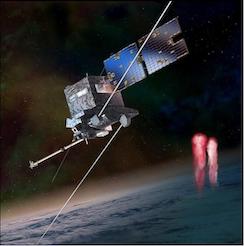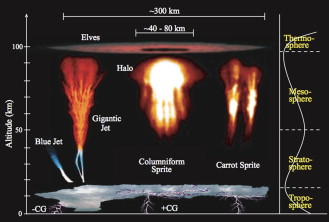|
|
TARANIS

The Tool for the Analysis of RAdiation from lightNIng and Sprites (TARANIS)
was a small atmospheric physics mission to study transient luminous events
(TLEs) and terrestrial gamma-ray flashes (TGFs).
TLEs are various types of electrical-discharge phenomena in the upper
atmosphere while TGFs are caused by intense electric fields produced
above or inside thunderstorms. TARANIS would have been the first satellite
designed to observe luminous, radiative and electromagnetic phenomena
occurring at altitudes of 20 to 100 km over thunderstorms.
It was to have been led by the National Centre for Space Studies
(CNES; Centre National d’études spatiales) with several
international partners with a two to four year mission. Its intended orbit
would have been a polar sun-synchronous orbit at an altitude of roughly 700 km.
To conserve power, the instruments would have cycled off at high latitudes;
Thunderstorm activity that predicates TLEs is quite rare in the Arctic and
Antarctic regions.
TARANIS was launched from Kourou Space Center, French Guiana, on
November 16, 2020 aboard a Vega rocket, but a malfunction in the upper
stage resulted in the lost of both TARANIS and a co-launched
satellite, SEOSat-Igneio.
TARANIS is equipped with an instruments set for a complementary study of TLEs, TGFs and associated emissions.
The payload includes :
- Micro Cameras and Photometers (MPC) consisting in two micro cameras one for lightning observation (600-800 nm), t
he second for TLEs observations (762 nm), and four photometers in different spectral bands (762 nm, 337 nm, 150-280 nm, 600-800 nm)
looking at the nadir,
- X-ray,
γ-ray, and Relativistic Electron (XGRE) experiment consisting in three X and gamma sensors (20 keV-10 MeV).
Each sensor contains four detector units made of “sandwiches”
with a layer of lanthanum bromide scintillator (LaBr3) encased in two layers of plastic scintillator.
The LaBr3 layer functions as a rapid response energetic photon spectrometer,
senstive in the range 20 keV – 12 MeV (spanning hard xray to gamma ray energies).
The plastic scintillation layers are sensitive to relavistic electrons (1–10 MeV)
and as an anti-coincidence detector for the LaBr3 spectrometer.
Each sensor has an effective area of 300 cm2.
The XGRE has a good time resolution (i μs accuracy with < 300 ns
deadtime), supports high count rates without saturation (∼105 cm-2 s-1), with 30% accuracy for energy
characterization at 20 keV, rising to 9% at 511 keV.
- Instrument for the Detection of high Energy Electrons (IDEE) consisting of two energetic electrons detectors (70 kev–4 Mev),
for the measurement of high energy electrons.
- Instrument for Electric Field and Magnetic Measurements (IME-BF/IME-HF and IMM) consisting of
three electic antennas 2 LF/MF (10 Hz-20 kHz), and 1 HF (100 kHz - 30 MHz)
and one magnetic antennae (few Hz–20 kHz and 10 kHz–1 MHz)
The operation strategy consists of a survey mode with a continuous monitoring of low resolution optical, field and particle data and an allert mode when an event occurs and all instruments initialte an high resolution data mode.

The TARANIS science objectives includes (
Blanc, E. et al. 2007) :
- Advance physical understanding of the links between TLEs and TGFs, in their source regions, and the environmental conditions (lightning activity, variations in the thermal plasma, occurrence of extensive atmospheric showers, etc)
- Identify the generation mechanisms for TLEs and TGFs and, in particular, the particle and wave field events which are involved in the generation processes or which are produced by the generation processes
- Evaluate the potential effects of TLEs, TGFs, and bursts of precipitated and accelerated electrons (in particular lightning induced electron precipitation and runaway electron beams) on the Earth atmosphere or on the radiation belts.
The TGE high energy events were first discovered by the BATSE instrument on the Compton Gamma Ray Observatory in the early 1990s.
BATSE showed a link between a TGF to an individual lightning strike occurring within a few milliseconds of the TGF demonstrating that
TGFs have an atmospheric origin and located in the Earth’s uppermost atmospheric layers, and associated to lightning.
Similar events were detected by RHESSI, AGILE and Fermi missions. However looking at longer TGF events (>1 ms), these data showed that
TGF were not due to the detection of gamma-rays, but to secondary electrons and positrons produced by the TGF
(known as Terrestrial Electron Beams,TEBs).
These charged particles beamed by the Earth magnetic field travel thousands of km between one hemisphere to the other and
may be detected in unusual locations for TGFs. These particle can be trapped by the geomagnetic field and they may provide
a significant source of high-energy (> 1 MeV) particles to the radiation belts. The impact of TEBs on radiation belts still needs to be quantified.
[TARANIS (CNES; France (English language)]
[TARANIS]
[Gallery]
[All Missions]
[by Time]
[by Energy]
Page authors: Lorella Angelini Jesse Allen
HEASARC Home |
Observatories |
Archive |
Calibration |
Software |
Tools |
Students/Teachers/Public
Last modified: Thursday, 22-Apr-2021 12:11:08 EDT
|